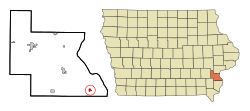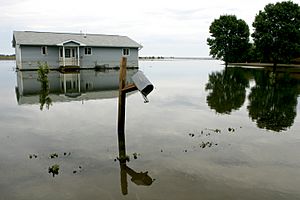Oakville, Iowa facts for kids
Quick facts for kids
Oakville, Iowa
|
|
|---|---|

Location of Oakville, Iowa
|
|
| Country | |
| State | |
| County | Louisa |
| Area | |
| • Total | 0.42 sq mi (1.09 km2) |
| • Land | 0.42 sq mi (1.08 km2) |
| • Water | 0.00 sq mi (0.01 km2) |
| Elevation | 541 ft (165 m) |
| Population
(2020)
|
|
| • Total | 200 |
| • Density | 479.62/sq mi (185.07/km2) |
| Time zone | UTC-6 (Central (CST)) |
| • Summer (DST) | UTC-5 (CDT) |
| ZIP code |
52646
|
| Area code(s) | 319 |
| FIPS code | 19-58395 |
| GNIS feature ID | 0459778 |
Oakville is a small city located in southeastern Louisa County, Iowa, in the United States. In 2020, about 200 people lived there. It is part of the larger Muscatine area.
Contents
History of Oakville
Oakville was founded in 1891.
Where is Oakville Located?
Oakville is found just north of Iowa Route X99. The Iowa River flows nearby, about half a mile to the northwest. The border between Louisa and Des Moines counties is two miles south.
Other nearby towns include Wapello, about six miles northwest. Keithsburg, Illinois is across the Mississippi River, about five miles to the east.
Size of the City
According to the United States Census Bureau, the city covers a total area of about 1.09 square kilometers (0.42 square miles). Most of this area, about 1.08 square kilometers (0.42 square miles), is land. A very small part, about 0.01 square kilometers (0.00 square miles), is water.
Who Lives in Oakville?
Population in 2020
As of the census in 2020, there were 200 people living in Oakville. These people lived in 84 households, and 56 of these were families. The city had about 479 people per square mile (185 people per square kilometer).
Most of the people living in Oakville were White (92.5%). A small number were Black or African American (0.5%). Some people were from two or more races (6.0%). About 3.0% of the population identified as Hispanic or Latino.
Households and Families
In the 84 households, about 34.5% had children under 18 years old living with them. About 44.0% were married couples living together. Some households had a female householder without a spouse (28.6%). Others had a male householder without a spouse (17.9%).
About 33.3% of all households were not families. This means they might be individuals living alone. About 9.5% of households had someone living alone who was 65 years old or older.
Age and Gender
The average age of people in Oakville was 37.5 years.
- About 27.0% of residents were under 20 years old.
- About 5.5% were between 20 and 24 years old.
- About 28.0% were between 25 and 44 years old.
- About 23.0% were between 45 and 64 years old.
- About 16.5% were 65 years old or older.
The city's population was made up of 51.0% males and 49.0% females.
Education in Oakville
The Wapello Community School District is responsible for operating the public schools in the Oakville area.
June 2008 Flooding Event

In June 2008, there was a very large flood across Iowa. The Iowa River overflowed its banks, causing significant damage in Oakville. The city faced a big challenge in recovering from this natural disaster.
See also
 In Spanish: Oakville (Iowa) para niños
In Spanish: Oakville (Iowa) para niños

